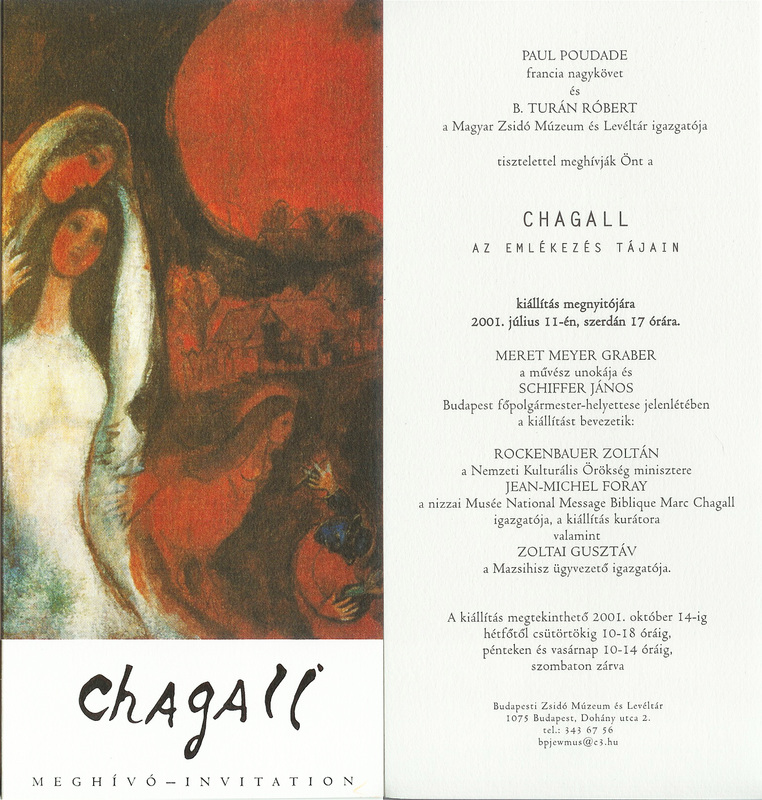|
2001. július 1 – 2001. október 14.
A lét méltósága: Először láthatunk Magyarországon ilyen széles válogatást Marc Chagall világából. A kiállítást a Budapesti Francia Intézet és a Magyar Zsidó Múzeum közösen rendezi. Az együttműködés példaértékű a francia-magyar kulturális kapcsolatokon belül. A kiállítás kurátora Jean-Michel Foray a nizzai Biblia Üzenet Múzeum igazgatója. Marc (Moshe) Chagall a korai modernizmus autentikusa, ám ez összefért zsidó hagyománytiszteletével. A művész az emlékezet olyan tájaira visz vissza bennünket, amelyből árad a Stetl iránti gyengédsége és szeretete, hisz hű maradt gyökereihez, a vityebszki zsidó család bensőségeihez. Sok képén látható a hagyomány őreként ábrázolt Rabbi, amint a Tóratekercset erősen szorítja magához, a történelem forgószele nehogy kitépje azt kezéből. Chagall Vityebszk szegény zsidóit mítikus hősökké avatta. Ők a jiddisül beszélő galliciánerek, a népi zsidóság. Párizsban újjászületett, noha az idegen élet megszállottságával érkezett oda, s az egyetlen valóságos dolog az elhagyott Vityebszk volt számára. „Az egész belső világunk valóság, talán még valóságosabb, mint a látható világ” – állapította meg a művész. Szeretet munkál bennük, nem gyűlölet-vagyis a lét méltósága! Talán így foglalhatnánk össze Chagall munkásságát. A francia környezethez asszimilálódás mégsem jelentette Chagall számára zsidó sorsközösségének, identitásának, értékes szellemi örökségének feladását. Így a Holocaustban sem a megszegett erkölcsi törvényt gyászolja elsősorban, mint Európa,- hanem a bennveszett zsidó testvéreit. March Chagall metaforikus művészetének titokzatos aurájához, annak megismeréséhez és megértéséhez segít hozzá minket e kiállítás. (Összefoglaló B. Turán Róbert írása alapján) Kurátorok: Jean-Michel Foray, Elisabeth Pacourd-Réme, B.Turán Róbert
2001. július 1 – 2001. október 14.
A lét méltósága: Először láthatunk Magyarországon ilyen széles válogatást Marc Chagall világából. A kiállítást a Budapesti Francia Intézet és a Magyar Zsidó Múzeum közösen rendezi. Az együttműködés példaértékű a francia-magyar kulturális kapcsolatokon belül. A kiállítás kurátora Jean-Michel Foray a nizzai Biblia Üzenet Múzeum igazgatója. Marc (Moshe) Chagall a korai modernizmus autentikusa, ám ez összefért zsidó hagyománytiszteletével. A művész az emlékezet olyan tájaira visz vissza bennünket, amelyből árad a Stetl iránti gyengédsége és szeretete, hisz hű maradt gyökereihez, a vityebszki zsidó család bensőségeihez. Sok képén látható a hagyomány őreként ábrázolt Rabbi, amint a Tóratekercset erősen szorítja magához, a történelem forgószele nehogy kitépje azt kezéből. Chagall Vityebszk szegény zsidóit mítikus hősökké avatta. Ők a jiddisül beszélő galliciánerek, a népi zsidóság. Párizsban újjászületett, noha az idegen élet megszállottságával érkezett oda, s az egyetlen valóságos dolog az elhagyott Vityebszk volt számára. „Az egész belső világunk valóság, talán még valóságosabb, mint a látható világ” – állapította meg a művész. Szeretet munkál bennük, nem gyűlölet-vagyis a lét méltósága! Talán így foglalhatnánk össze Chagall munkásságát. A francia környezethez asszimilálódás mégsem jelentette Chagall számára zsidó sorsközösségének, identitásának, értékes szellemi örökségének feladását. Így a Holocaustban sem a megszegett erkölcsi törvényt gyászolja elsősorban, mint Európa,- hanem a bennveszett zsidó testvéreit. March Chagall metaforikus művészetének titokzatos aurájához, annak megismeréséhez és megértéséhez segít hozzá minket e kiállítás. (Összefoglaló B. Turán Róbert írása alapján) Kurátorok: Jean-Michel Foray, Elisabeth Pacourd-Réme, B. Turán Róbert
1st July 2001 – 14th October 2001
Dignity of existence: We can see such a wide selection from the world of Marc Chagall for the first time in Hungary. The exhibition is organized jointly by the French Institute in Budapest and the Hungarian Jewish Museum. The cooperation is exemplary within the Franco-Hungarian cultural relations. The curator of the exhibition is Jean-Michel Foray, director of the National Museum Marc Chagall Biblical Message in Nice. Marc (Moshe) Chagall is an authentic person of early modernism, but it was assorted with his Jewish traditionalism. The artist brings us back to landscapes of remembrance from which his tenderness and love for Stetl emanates, for he remained true to his roots, to the intimacy of the Jewish family in Vitebsk. Many of his paintings show the Rabbi, portrayed as the guardian of tradition, unclasping the Torah Scroll tightly, so that the whirlwind of history does not tear it out of his hands. Chagall inaugurated the poor Jews of Vitebsk into mythical heroes. They are the Yiddish-speaking Gallicians, the folk Jewry. He was reborn in Paris, though he got there with an obsession with foreign life, and the only real thing for him was the abandoned Vitebsk. ”Our whole inner world is a reality, perhaps even more real than the visible world”, stated the artist. Love works in them, not hate – that is, the dignity of existence. Maybe that’s how we could summarize Chagall’s work. However, assimilation to the French environment did not mean giving up his Jewish common fate, identity or spiritual heritage. Therefore, in the Holocaust, he does not mourn the violated moral law in the first place, like Europe does, but his lost Jewish brothers and sisters. The exhibition helps us knowing and understanding the mysterious aura of Marc Chagall’s metaphoric art. (Summary written by Róbert B. Turán) Curators: Jean-Michel Foray, Elisabeth Pacourd-Réme, Róbert B. Turán
0 Comments
Leave a Reply. |
Tartalom:A Magyar Zsidó Múzeum és Levéltár kiállításai Categories |

 RSS Feed
RSS Feed